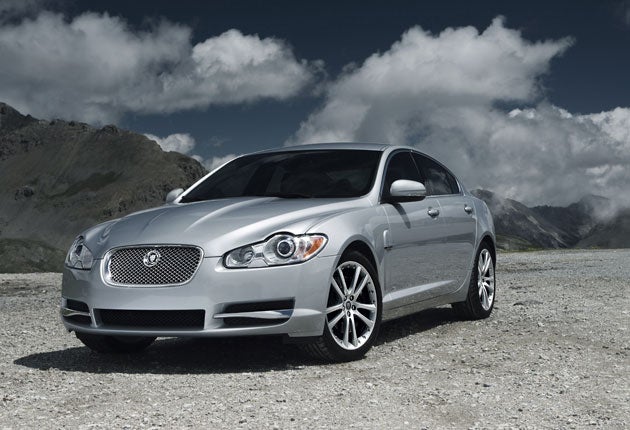Jaguar XF
New owners, new models and a brilliantly redesigned diesel engine all point to Jaguar surviving the current crisis

Your support helps us to tell the story
From reproductive rights to climate change to Big Tech, The Independent is on the ground when the story is developing. Whether it's investigating the financials of Elon Musk's pro-Trump PAC or producing our latest documentary, 'The A Word', which shines a light on the American women fighting for reproductive rights, we know how important it is to parse out the facts from the messaging.
At such a critical moment in US history, we need reporters on the ground. Your donation allows us to keep sending journalists to speak to both sides of the story.
The Independent is trusted by Americans across the entire political spectrum. And unlike many other quality news outlets, we choose not to lock Americans out of our reporting and analysis with paywalls. We believe quality journalism should be available to everyone, paid for by those who can afford it.
Your support makes all the difference.If I ran Jaguar, my stress levels would be in the red zone, but managing director Mike O'Driscoll seems remarkably calm. Maybe it's because he genuinely believes it's going to be all right. And why shouldn't it be?
Because Jaguar got a new owner last year, it recently launched the XF saloon; it has just launched a whole new range of engines (thus rendering those first XFs obsolescent), and soon it will reveal a new XJ saloon as futuristic as the current one is retrogressive. So there's a lot to think about.
The new owner, Indian industrial conglomerate Tata, has a light touch and allows Jaguar a freedom it lacked under Ford. The new-model plan is no longer becalmed and a new sports car, smaller than the XK, is now almost certainly going to happen. Jaguar is working on the assumption that the credit crunch will end (to do otherwise is short-term defeatism), and with its new diesel engine it will make hay.
That engine is the centrepiece of this test. Jaguar has had a 2.7-litre V6 turbodiesel for several years, a unit co-designed by Ford and Peugeot-Citroë*and built at Ford's Dagenham factory. Now it has been redesigned and expanded to 3.0 litres, and its twin turbochargers now operate sequentially.
Some figures. The old engine produced 207bhp and a healthy, so we thought, 320lb/ft of pulling power, while posting an official CO2 output of 199g/km. The new one manages either 240 or 275bhp and either 369 or 443lb/ft, the higher outputs belonging to the S version, while both generate just 179g/km of CO2 on the standard test cycle. (So why bother with the gentler one?) These are massive improvements, and the sequential turbo system is why.
Most of the time just one turbo is used, a large one with variable geometry to enable it to mimic a smaller one when needed and thus give a quick response from low engine speeds. The secondary turbo is smaller and has a fixed geometry, so the whole system is the reverse of most other sequential-turbo arrangements in which a small turbo is joined by a larger one as demands on the engine increase.
It means the engine can run on one turbo for more of the time, which improves efficiency by creating a clearer path for the intake air. When not in use, the secondary turbo is blanked off by a valve to prevent turbulence caused by air from finding its way to where it is not needed. Other valves ensure a lot of exhaust gas is recirculated when the engine is running on a light load, which slows down the fuel's rate of burning and reduces emissions of nitrogen oxides, always a problem with diesel engines. The plumbing is arranged to keep those exhaust gases hot and to keep the incoming fuel cool, both of which improve fuel efficiency.
Still with me? The crucial point is that it works. Allow me to set the scene via a slight digression, in the shape of the latest XF V8 with its also-new 5.0-litre, 510bhp engine. This car should feel terrific to drive, if not quite as heroic as the supercharged XFR, but it doesn't quite hit the mark. It feels a little nose-heavy when threaded along sinuous roads;, its suspension is less supple over bumps than a luxurious Jaguar saloon's should be, and its automatic transmission turns ludicrously manic in Sport mode.
An encounter with the V8, then, focuses more clearly our expectations of the turbodiesel. They are rewarded with the revelation that the diesel S is the best XF of all. The smooth V6-ness of the engine note gains the upper hand over any diesel gruffness once warmed up, and such is the torrent of pulling power that hills might as well not exist. Sinuous mountain roads, the sort that flummox the V8 more than they should, are where the diesel really shines although it's a laid-back cruiser, too. The engine delivers its biggest shove at just 2,000rpm and the automatic gearbox's shifting logic is tuned to suit, so there's much less agitated shifting up and down the gears, making progress calmer but still extraordinarily rapid. Sport mode still isn't perfect, though, because it tries to avoid fifth and sixth gears. So you have to revert to Drive or use the excellent manual paddle-shifters.
A fringe diesel benefit is that this XF feels more agile than the V8, thanks to lighter, crisper steering, and it rides more lightfootedly over bumps. All this comes in a handsome package with the most original and intriguing interior in the class, and from £36,900 (non-S from £33,900). We'll be seeing a lot of XFs on the road with these new diesel engines, because any other version is surely an extravagance.
Join our commenting forum
Join thought-provoking conversations, follow other Independent readers and see their replies
Comments